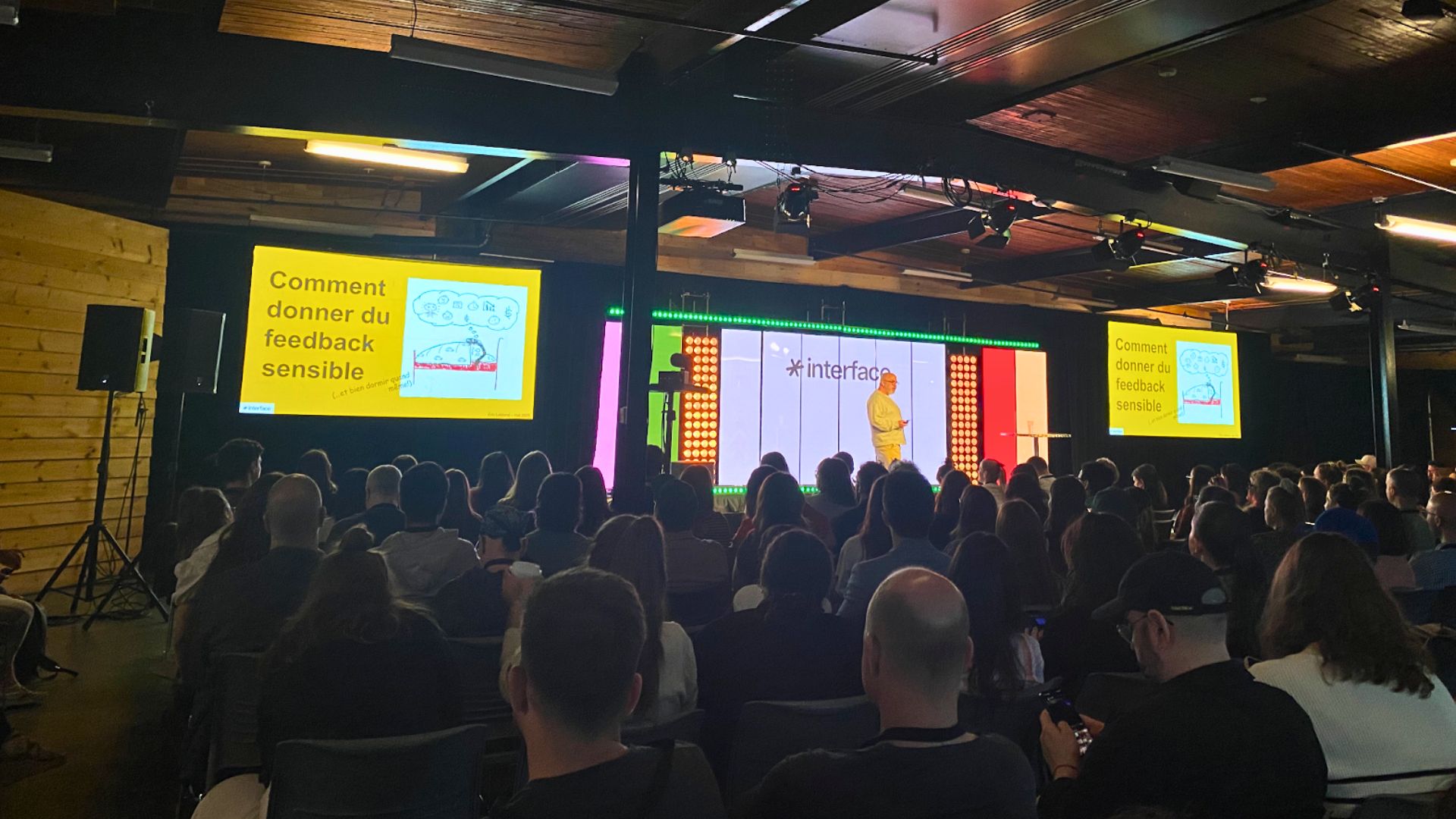Le 3e Sommet du développement professionnel en éducation (#SommetDP) était fort attendu. L’événement, organisé par le CADRE21 et de nombreux partenaires (dont l’École branchée), avait été reporté l’an dernier en raison de la pandémie. L’attente en aura valu la peine et les échanges particulièrement riches tout au long de la journée, autant sur scène entre les panélistes invités que dans le clavardage entre les participants.
« Le développement professionnel est un processus complexe qui doit se faire en synergie entre les divers acteurs, que ce soit ceux de proximité ou de plus loin. En 2022, bien des possibilités s’offrent à nous », a témoigné Isabelle Turcotte, du Centre de services scolaire des Premières-Seigneuries, dans le clavardage.
Le 3e Sommet DP visait à mettre en lumière les conditions gagnantes du développement professionnel sur le terrain sous trois angles en particulier : la formation continue , le leadership et l’accompagnement, ainsi que l’insertion professionnelle. Nous vous présentons un résumé des échanges autour de chaque thème.
Panel sur la formation continue
« Il faut miser sur le désir d’enseigner et le plaisir d’apprendre ou le plaisir d’enseigner et le désir d’apprendre », a indiqué Henri Boudreault, vice-doyen aux études de la faculté des sciences de l’éducation de l’UQAM.
Le nouveau Référentiel de compétences professionnelles de la profession enseignante du ministère de l’Éducation du Québec a été au cœur du premier panel de la journée. Rappelons que ce référentiel a été mis à jour et publié au cours des tout derniers mois.
Les panélistes ont d’abord été invités à nommer les compétences qui étaient les plus importantes pour eux. Les compétences 9 et 10, qui visent la collaboration (S’impliquer activement au sein de l’équipe-école et Collaborer avec la famille et les partenaires de la communauté), et la compétence 13, qui touche au savoir-être (Agir en accord avec les principes éthiques de la profession), ont particulièrement été mises de l’avant.
Les panélistes ont fait valoir à tour de rôle que la formation initiale n’est plus une fin en soi mais qu’elle doit être considérée comme un premier jalon vers d’autres démarches d’apprentissage. Tous ont intérêt à adopter une posture d’apprenant tout au long de la vie. L’enseignant, c’est ni plus ni moins que l’apprenant en chef dans sa classe!
D’ailleurs, le défi pour le milieu universitaire de se rapprocher de la pratique subsiste toujours. « Il y a un enjeu d’arrimage entre la formation initiale des enseignants et la réalité sur le terrain. Il faut réussir à donner du sens. Il faut amener les étudiants à développer leur capacité d’adaptation, car les réalités dans les écoles sont dynamiques et changent constamment », a d’ailleurs soutenu M. Boudreault.
De plus, la collaboration entre les enseignants est apparue comme un élément central de la formation continue. « Le pire ennemi d’un enseignant, c’est lui-même s’il travaille seul », a lancé M. Boudreault sans détour. Néanmoins, la collaboration doit être organisée et planifiée afin qu’elle donne des résultats. En se fixant des objectifs précis, en réunissant les personnes intéressées et en offrant des espaces de rétroaction et d’application concrète et rapide, il est possible d’arriver à des résultats positifs.
« Donnons du temps, des moments, des situations pour permettre aux enseignants de se rencontrer et d’échanger. Il faut provoquer l’entraide et le partage », a aussi dit M. Boudreault. Tel que plusieurs l’ont souligné toutefois, le temps fait cruellement défaut dans le monde scolaire. Cela demeure un défi pour tous.
Collaboration vs. Coopération
- Collaboration : Tirer profit des forces de chacun pour mener un projet
- Coopération : Séparer les tâches entre chaque individu pour mener un projet
Voici le croquinote (sketchnote) réalisé par notre collègue Laurie Couture pour résumer les échanges du premier panel :

Panel Leadership et accompagnement
« En tant que directrice d’école, la collaboration avec le conseiller pédagogique est indispensable pour moi, pour le développement professionnel de mon équipe-école et la réussite des élèves », a écrit Anne-Claude Poirier dans le clavardage.
Tel un fil conducteur, la compétence à collaborer a fait partie du 2e panel de la journée alors que les composantes et les manifestations de la compétence conjuguée ont été au centre des échanges. La compétence conjuguée fait référence à une dyade de travail formée d’un conseiller pédagogique et d’une direction d’école. Les deux sont jumelés afin de tirer profit des forces de l’un et l’autre et de faire émerger une forme de collaboration interprofessionnelle.
Encore une fois, les panélistes ont tenu à préciser qu’il ne suffit pas de placer deux personnes ensemble pour que des résultats probants émergent. « On ne peut pas forcer la collaboration, il faut la susciter, mettre des conditions gagnantes en place. » Par ailleurs, dans le milieu scolaire, la réussite des élèves devrait toujours être en toile de fond de toute collaboration.
De façon concrète, la compétence conjuguée implique de :
- Créer une alliance de travail;
- Planifier des situations d’action en fonction de la visée établie;
- Mobiliser les ressources interactives nécessaires à la situation d’intervention;
- Réguler les pratiques tout au cours de la situation d’intervention professionnelle.
Bref, il faut y croire, se donner le temps et les moyens, puis persévérer dans toute démarche d’accompagnement et de collaboration. Si la collaboration doit être planifiée, elle doit aussi laisser la place à la flexibilité. « Il faut parfois reculer pour mieux avancer. »
L’objectif ultime de la compétence conjuguée est de permettre aux deux jumelés de développer une complicité professionnelle.
Voici le croquinote (sketchnote) réalisé par Amy Tran pour résumer les échanges du premier panel :

Panel sur l’insertion professionnelle
« Le soutien psychologique est très important dans les métiers de l’enseignement », a commenté Khadija Himmi dans le clavardage.
Le contexte actuel ne permet plus de faire fi des enjeux d’insertion professionnelle dans la profession enseignante. Bien qu’il y ait une intention commune de favoriser le bien-être des enseignants novices, qui sortent de l’université, et des nouveaux enseignants « non-détenteurs de brevet » (ou « non-légalement qualifiés » – NLQ), qui sont de plus en plus nombreux, il existe encore bien peu de données permettant d’évaluer et quantifier les actions mises en place.
La discussion qui s’est tenue lors du 3e panel a fait place à la bienveillance, à l’ouverture et à l’importance de la création de liens entre les enseignants débutants et leur milieu. « L’accueil est une clé tellement importante dans le bien-être professionnel », a d’ailleurs réagi Hélène Cormier dans le clavardage.
Il apparaît que, dans le brou-ha-ha permanent dans les écoles, les enseignants novices ont peur de demander de l’aide à leurs collègues. Ils craigneraient de déranger, d’être mal perçus avec leurs questions. C’est ainsi que les panélistes ont nommé l’importance de créer un climat favorable pour accueillir les nouveaux enseignants. La salle du personnel devient alors un un lieu central qui doit être synonyme de positivisme.
Par exemple, Karina Saint-Germain, du Centre de services scolaire de Saint-Hyacinthe, a partagé une expérience d’accueil des enseignants « non-détenteurs de brevet » : cinq demi-journées de formation ont été offertes aux nouveaux enseignants en août, juste avant la rentrée, afin de favoriser leur insertion et de leur présenter les personnes à consulter en cas de besoin (présentation du fonctionnement des écoles, ressources utilisées, stratégies d’enseignement, gestion de classe, planification et évaluation des apprentissages, etc.)
Tout intervenant d’expérience dans une école peut avoir une influence positive sur des enseignants novices. Chaque petit geste compte. Voilà ce qui est ressorti des échanges.
Voici le croquinote (sketchnote) réalisé par Marie-Andrée Ouimet pour résumer les échanges du premier panel :

Et en prime, une photo prise derrière la scène de ce dernier panel de la journée, animée par notre collègue Stéphanie Dionne :

Les enregistrements des trois panels et de la synthèse de la journée seront disponibles sur le site Web du Sommet DP dans les prochains jours.














